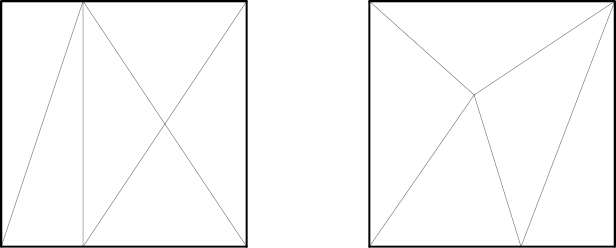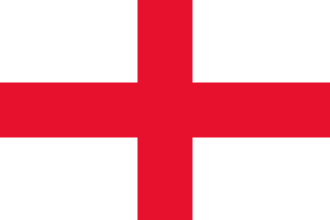
A square can be divided into an even number of triangles of equal area — but not into an odd number.

A square can be divided into an even number of triangles of equal area — but not into an odd number.
A puzzle by Virginia McCarthy:
A 20-story office building has one busy elevator. On a recent trip upward, the elevator transported seven passengers. Each of these went up at least two floors, but no two of them went up the same number of floors. On this one upward journey, no more than one passenger crossed the elevator’s threshold on any given floor; no passenger exited on the 17th floor; and the elevator’s doors opened at more odd-numbered floors than even-numbered floors. Anton was the last passenger on and the second one off. Bessie got on before Clara and after Dagwood and went up more floors than Dagwood did. Edsel went up exactly twice as many floors as Filbert and got off before Gerda got on. Gerda was not the last one to exit.
Where did each passenger enter and exit the elevator?
Every unjust act is inexpedient;
No unjust act is expedient;
No expedient act is unjust;
Therefore every expedient act is just.
— Ralph L. Woods, How to Torture Your Mind, 1969
He was prettily and fantastically troubled, who, having used to put his trust in dreams, one night dreamed that all dreams were vain; for he considered, if so, then this was vain, and then dreams might be true for all this: but if they might be true, then this dream might be so upon equal reason: and then dreams were vain, because this dream which told him so was true; and so round again.
— Jeremy Taylor (1613–1667), “The Deceitfulness of the Heart”
This curious epitaph is found at Martham Church in Norfolk:
Here Lyeth the Body of Christr. Burraway, who departed this
Life ye 18 day of October, Anno Domini 1730.
Aged 59 years.
And there Lyes ☞
Alice who by his Life
Was my Sister, my mistress
My mother and my wife.
Dyed Feb. ye 12. 1729
Aged 76 years.
According to Thomas Joseph Pettigrew in Chronicles of the Tombs (1888), in 1670 Martham farmer Christopher Burraway had seduced his daughter, Alice, and she had borne him a son, who was placed at a foundling home. When the son turned 20 he was apprenticed to a farmer and eventually came to Martham, where he applied to Alice for a job, not knowing their relation. By this time the father was dead. She hired him and eventually married him, becoming “mother, sister, mistress and wife, to this modern Œedipus.”
At age 76 she recognized a peculiar mark on his shoulder and, realizing she’d married her son, “was so horror stricken that she soon after died, he surviving her scarcely four months.”
See Endless Love.

The Moscow Radio announced that five million Russians filed past Josef Stalin’s bier in 72 hours. That means, according to the calculations of Frank Baker, a Mangum, Okla., accountant, that the mourners, two abreast, three and one third feet apart, ran past the bier at 22 miles an hour. Twenty-two miles an hour is 9.3 seconds a hundred yards, which is the world’s record for the 100-yard dash — heretofore recorded only by America’s Mel Patton.
— Associated Press, Sept. 24, 1953
“If the northern hemisphere were land, and all the southern hemisphere water, ought we to call the northern hemisphere an island, or the southern hemisphere a lake?” — Augustus De Morgan

A “simple but pretty little puzzle” by Henry Dudeney: If this flag measures 4 feet by 3 feet and presents equal areas of red and white bunting, how wide are the cross’s arms?
The French phrase ouate de phoque (“seal’s cotton wool”) sounds like what the fuck in English.
For whatever that’s worth.
Because it depends partly on the phase of the moon, the date of Easter Sunday can vary by as much as 35 days.
In 1928, the Parliament of the United Kingdom passed an act that would establish its date as the Sunday following the second Saturday in April (and thus always falling between April 9 and 15).
Though passed and enacted, the act has never come into force because the British government agreed that the change would need to be made in consultation with church leaders. It’s known as the Easter Act 1928.
(In the meantime, here’s a mnemonic for remembering the current system.)